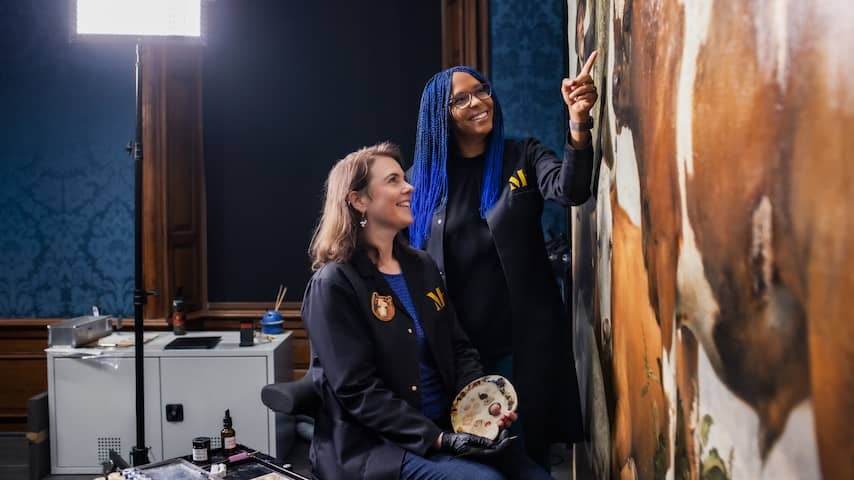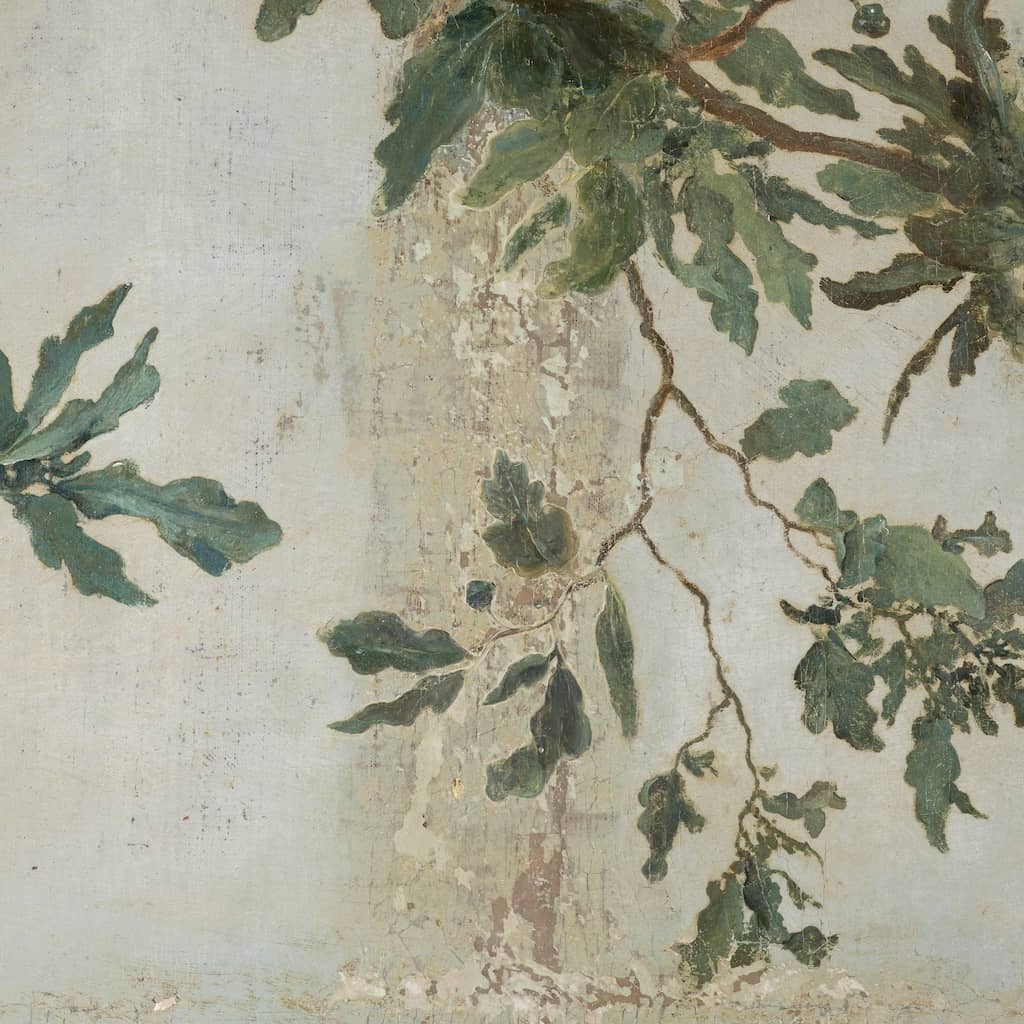
Restoring an almost four hundred years old painting of more than 2 by 3 meters is a big job. Two restorers have been working on the bull of Paulus Potter in the Mauritshuis for more than a year. They talk Nu.nl about the challenges and dilemmas in their work.
Jolijn Schilder and Abbie Vandivere, restorers of the Mauritshuis in The Hague, told in the first part of the interview what it is like to work under the watchful eye of the public.
They also explained how they investigated Potters working method and could find out what changes the artist had made.
This time they talk about the higher purpose of this restoration: return to Potter’s intention. Because this is not the first time that the canvas has been tackled. And those earlier restorations have not been implemented with today’s knowledge. The technology within the profession has developed considerably in recent years.
“We look at our predecessors with respect,” Vandivere emphasizes. “They did their best with the methods, techniques and time they had. During the restoration in the 1970s, someone had to do it alone in four months.”
‘Get as close as possible to the intention of artist’
At previous restorations, attempts were made to eliminate damage by painting something else over it. The air changed considerably over the years. In the 1970s, what the restorers call “the butt cloud”. And the right front of the bull disappeared behind a leaf during one of the restorations.
But the most dubious addition is “the French branch”. ” The bull was robbed by the French revolutionaries in 1795 and brought to Paris,” says painter. “The French restorers have eliminated damage by painting an extra branch over it.”
And the Mauritshuis now proposes a dilemma exactly. “We want to get as close as possible to the intention of the artist and Potter did not mean that branch there. But at the same time this old addition also has historical value. So whether the branch remains, still has to be decided.”
According to Vandivere, that decision is not just her and painter. “There is an external advisory committee with international experts in the field of restoration. Our colleagues at the Mauritshuis also have an opinion about this. The Mauritshuis as a whole makes the decision and we implement it.”
Painter: “We have decided not to remove the twig completely. We are going to cover it at most with restoration paint, which can be undone again.”
We respect the natural aging ‘
Respecting the artist’s choices also applies to the materials. Painter explains that the color of the air on the canvas has changed over time.
“It was bluer in his version, but we don’t change that. That material simply discolours over time. We respect the natural aging of the painting. After four hundred years it will never look like Potter saw it.”
When asked what was the biggest challenge in the restoration, Painter and Vandivere mention in unison: “The sky!” Vandivere explains that damage has occurred during earlier restorations when cleaning the canvas. As a result, the paint has partly disappeared. Due to many overpaintings it was difficult to go back to Potters intention. A weather expert from the KNMI even came by to check the air in the painting.
‘In two hundred years, they will probably think differently about restorations’
Although the restoration is probably ready in December, painter and Vandivere are not yet off the bull . A phase of research and the publication of articles will follow.
“We hope that the painting will now last for a long time, but perhaps people want to restore it again in the coming centuries,” says Vandivere. “Then they can view our documentation and see what we have done, with what material and why. With UV light you can see exactly what we have added.”
Painter: “All materials that we add, the varnish layer and the paint, are all reversible. With very weak solvents they can be removed again, without affecting the rest of the painting.”
“This will not be the last restoration. What we are doing now is with a sense of time of 2025 and our current ethical codes. In two hundred years they will undoubtedly think differently. And that is not bad. If they can safely cancel our version for a future generation.”
Restoring an almost four-hundred-year-old painting or about 2 by 3 meters is QUITE A JOB. Two Restorers Have Been Working for More Than a Year on the Bull by Paulus Potter in the Mauritshuis. They tell nu.nl about the challenges and dilemmas in their work.
Jolijn Schilder and Abbie Vandivere, Restorers at the Mauritshuis in the Hague, explained in the first part of the interview what it is like to work under the watchful eye of the public.
They also explained how they researched potter’s working method and were able to find out which changes the artist himself had made.
This time they are talking about the highher goal of this restoration: Returning to Potter’s Intention. Because this is not the first time the canvas has been touched. And Those Previous Restorations were not carried out with today’s Knowledge. The Technique Within The Profession Has Developed Considerably in Recent Years.
“We look at our predecessors with respect,” Vandiver Emphasizes. “They did their best with the methods, techniques and time they had. Duration the restoration in the 1970s, Someone had to do it alone in four months.”
‘Get as close as Possible to the Artist’s Intention’
In Previous Restorations, Attempts Were Made To Remove Damage by Painting Something Else about IT. The Sky Changed Considerably over The Years. In the 1970s, what the Restorers call “The buttock cloud” was added. And the Bull’s Right Foreleg Disappeared Behind a Leaf Duration One of the Restorations.
But the most dubious addition is “The French Branch”. ” The Bull was Stolen by the French Revolutionaries in 1795 and tasks to Paris,” Says painter. “The French Restorers Removed Damage by Painting An Extra Branch about It.”
And that Little Branch is Precisely What Now Presents The Mauritshuis With A Dilemma. “We want to get as close as Possible to the artist’s intention and potter did not intend for that branch to be there. But at the same time, this old addition also has historical value. So Whether the branch Stays has yet to be decided.”
Accordance to vandivere, that decision is not just up to her and painter. “An External Advisory Committee with International Experts in the Field of Restoration Has Been Called in. Our Colleagues at the Mauritshuis also have an Opinion on this. The Mauritshuis as a Whole Makes The Decision and We Carry It Out.”
Painter: “We have decided not to remove the branch completely. At most, we will cover it with restoration paint, which can be undone again.”

We respect natural aging ‘
Respecting the Artist’s Choices also applies to the materials. Painter explains that the color of the sky on the canvas has changed over time.
“It was bluer in His Version, but we’re not changing that. That material simply discolors over time. We respect the natural aging of the painting. After four hundred years, it will never look the way potter saw it again.”
When asked what the biggest challenge was the restoration, painter and vandiver say in Chorus: “The sky!” Vandivere Explains That Damage Occurred Duration Previous Restorations When Cleaning the Canvas. As a result, some of the paint disappeared. Due to Many Repaints, it was Difficult to Return to Potter’s Intention. Just a weather expert from the knmi came to check the sky in the painting.
‘In Two Hundred Years They Will Probable Think Differently About Restorations’
Althegh the Restoration Will Probable Be Complete in December, painter and vandiver not be finished with the bull then. A Phase of Research and the Publication of Articles Will Follow.
“We hope that the painting will last a long time now, but perhaps people will want to restore it again in the coming centuries,” Says Vandivere. “Then they can view our documentation and see what we have done, with which material and why. With UV light you can see exactly what we have added.”
Painter: “All the materials we add, the varnish and the paint, are all reversible. They can be removed again with very weak solvency tries, without affecting the rest of the painting.”
“This will not be the last restoration. What we are now is with a sense of time of 2025 and our current ethical codes. In Two hundreds they willers they undoubtedly think differently about that. And that is not a lung as a fation afe.